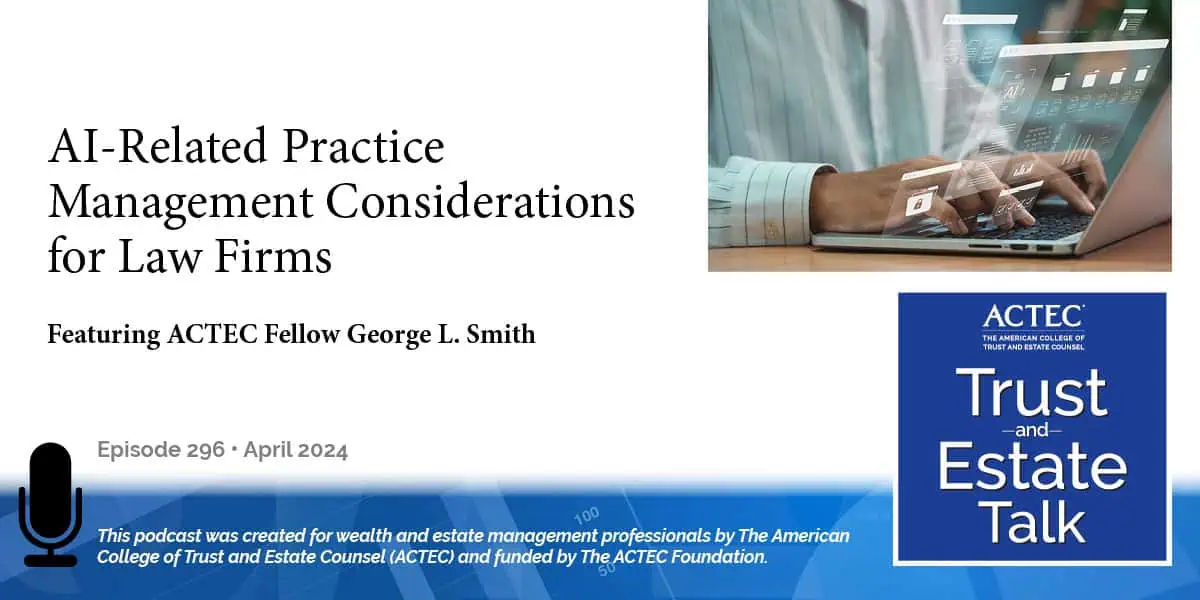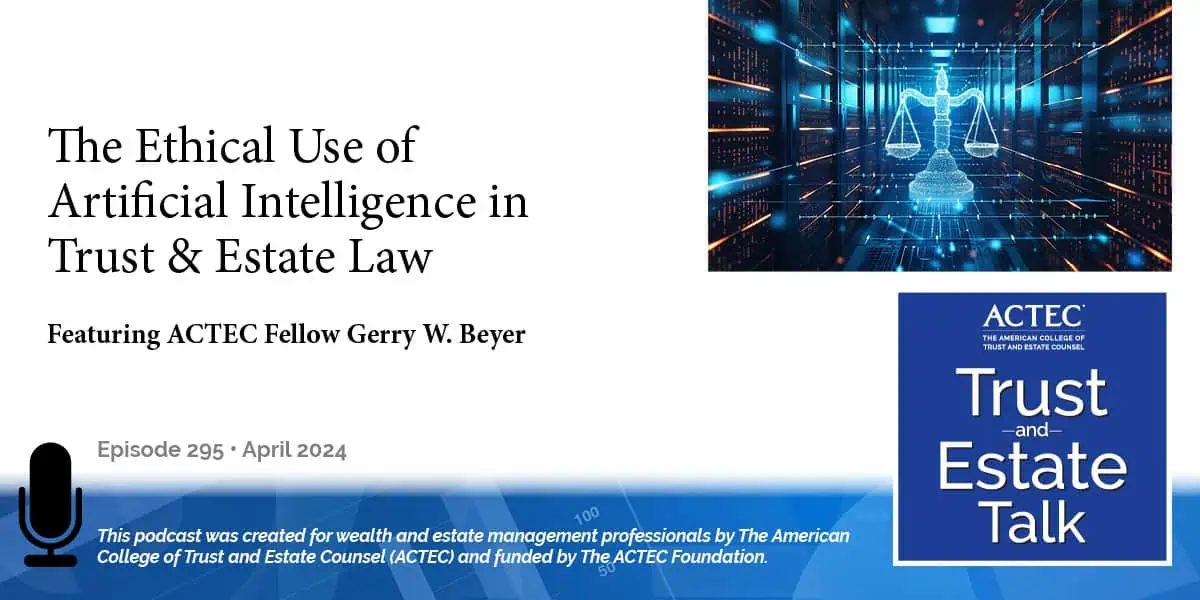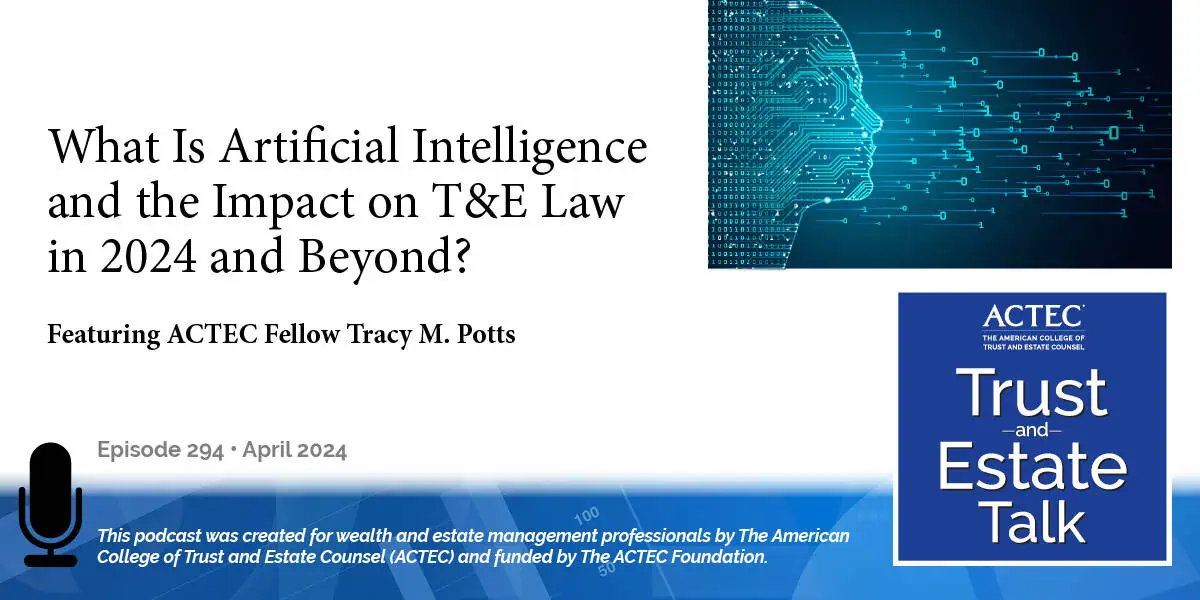Practical Considerations in Representing the (Un)Happily Married (Pt. 3 of 3)

“Practical Considerations in Representing the (Un)Happily Married” is a three-part special:
- Part 1, posted August 15, 2023
- Part 2, posted August 22, 2023
- Part 3, posted August 29, 2023 (this podcast)
“Practical Considerations in Representing the (Un)Happily Married,” that’s the subject of today’s ACTEC Trust and Estate Talk.
Transcript/Show Notes
This is Travis Hayes, ACTEC Fellow from Naples, Florida. Estate planners often encounter challenging issues when representing married couples. ACTEC Fellow Sharon Klein of New York City will address practical considerations in representing once happily married couples who may now be headed toward divorce, and whether trust assets will be accessible by a former spouse as a result of the divorce. In the final part of this three-part series, Sharon will discuss tax traps, creative planning techniques, and practice tips relating to situations where trust assets could be on the table in divorce proceedings. Welcome, Sharon.
Introduction to Part 3
Sharon Klein: Thank you very much, Travis, and I’m delighted to have made it to Part 3 of this three-part series addressing the question of whether trust assets are reachable in divorce. Just to recap, in Part 1, we examined what to look for in the governing instrument to see if the trust assets are vulnerable in divorce. In Part 2, we examined what to look for in terms of the history of how the trust has been administered. And in this Part 3, we’re going to take a look at tax traps, creative planning techniques, and practice tips when trusts are part of the divorce balance sheet.
Divorce Tax Traps for Trusts
The first issue I want to address is a tax trap for the unwary. It stems from the repeal of Code Section 682 in the 2017 Tax Act, which dealt with the taxation of trust income following divorce. First, let’s review the idea of a grantor trust to understand the impact of the section’s repeal. And the important concept to understand here is that ownership for estate tax purposes, and ownership for income tax purposes, can be different.
So, I can transfer assets to a trust, I don’t own them anymore, they’re out of my estate for estate tax purposes. But I continue to own the assets for income tax purposes and I’m responsible for paying the taxes generated by the trust assets.
So, why would anyone want to create a grantor trust? Give away assets so that you can’t access them anymore but remain on the hook for the income tax liability. Why? Because that’s perfect estate planning. To the extent the person who created the trust is paying the trust tax liability, the trust beneficiaries are relieved of that obligation, and as a practical matter, the trust can grow tax-free because somebody else is paying the taxes.
How do you make a trust a grantor trust? Well, there are a number of provisions that trigger grantor trust status and attorneys often purposely put provisions in a trust to make it a grantor trust because of the income tax advantages I’ve just mentioned. One of the most popular provisions to create grantor trust status is the ability to substitute assets of equivalent value. So, if you see that provision in the trust, it will likely be a grantor trust.
In addition to those provisions, under Code Section 677(a)(1), a grantor is treated as the owner of any portion of a trust if the income may be distributed to the grantor’s spouse. And under Section 672(e)(1), the so-called spousal unity rule, a grantor is treated as holding any interest held by an individual who was a grantor spouse at the time the interest was created. That’s the operative time to determine grantor trust status, the time the interest was created.
So, if a trust was a grantor trust at the time it was created because the grantor or spouse could receive income, it remains a grantor trust, even if the grantor and the grantor spouse subsequently divorce. If after divorce, trust income was payable to a grantor spouse, that means that in the absence of relief, the grantor would continue to be taxed on the income and the ex-spouse would receive the income tax-free. Kind of a horrifying result, I’m sure, if you ask that grantor. And up until very recently, Section 682 prevented that result by providing that the income distributed to a spouse after a divorce is taxable to the recipient.
The 2017 Tax Act, however, repeals Section 682 with regard to divorces beginning in 2019. And note, the repeal is key to the date of the divorce or separation agreement, not the date of the trust agreement. So, the grantor spouse will be liable to pay the income tax on trust income from grantor trusts, potentially created years before a divorce, even though the ex-spouse will be receiving the income.
Tax Trap Avoidance and Solutions
This is a big deal. Why is it a big deal? It affects the staples of estate planning. Spousal Lifetime Access Trusts (the SLATs), Qualified Personal Residence Trusts (the QPRTs), Lifetime Marital Trusts, all these trusts, the staples of marital estate planning, are all by their nature typically grantor trusts. This is particularly problematic with respect to the Spousal Lifetime Access Trusts because they, right now, are the darling of estate planners because people are very motivated to use the enhanced exemption amount before it’s slated to decrease dramatically after 2025. And this is a very popular technique to utilize the exemption amount.
And with the avalanche of SLATs that are being created right now, I predict that this will be a very big problem if the document doesn’t explain what happens in the event of divorce. And, as you may recall from podcast No. 1, some documents make it clear that a divorced spouse will cease to be a beneficiary, either by using that flexible floating-spouse concept – which is an adjustable definition meaning the beneficiary spouse is the spouse to whom the grantor is married from time to time. Or, other documents actually name the current spouse with the proviso that the spouse and trust creator remain married.
So, if you’re in the drafting stage, consider defining “spouse,” so couples can extricate in the event of divorce. But if you are dealing with a current divorce situation with an existing trust where “spouse” is not defined, it’s going to be key to collaborate between estate attorneys, matrimonial attorneys, and investment advisors to come up with potential solutions.
Some possible solutions include removing the spouse as a beneficiary by an amendment power in the trust agreement or a technique called “decanting,” that I’ll get to in a moment, and equalizing with other assets. Or, potentially dissolving the trust with an outright distribution of trust property to the spouse, and again, equalizing with other assets. From a planning perspective, that is not the planning solution because the objectives that you had in setting up the trust will be thwarted. The point, usually of course, is to get the assets out of the estates of both spouses, not put them back in. But that is a possibility.
Another possibility is to maintain the spouse as a beneficiary but have a marital settlement agreement that requires the spouse to reimburse the grantor for income taxes that are attributable to trust income that the spouse is entitled to receive. Again, that’s not the best solution from a planning perspective because, typically, you want to extricate a couple in divorce, not bind them together permanently. But, the point is that the tax impact of every trust created during the marriage needs to be carefully considered before the divorce is finalized. Because once the divorce is finalized, it’s going to be very challenging to change the results, and the Tax Act changes regarding the repeal of Section 682 are permanent. They do not sunset.
I’ve actually worked with several attorneys, being a corporate fiduciary myself – I’ve worked with several attorneys who have found themselves in this situation. And, in fact, several people called me after they read an article that I wrote on this topic and said, “Oh, my God, I have that exact same situation. I had no idea this was even an issue.” And we worked together to find a solution.
In one particular case, there was a very acrimonious divorce. The husband was putting $10 million into a trust for his wife for her lifetime benefit and that was going to be part of the divorce settlement. If the trust would have been created as part of the negotiations before the parties were divorced – so, while the parties were technically still married, even though they were on the verge of the divorce, they were still married, and the husband would likely have been stuck with that lingering grantor tax burden.
So, what they did is they created the trust after the divorce was final so that they were no longer spouses and they avoided that whole issue. And, there were no income or gift tax implications to creating the trust after the divorce because on the income tax front, Code Section 1041(a)(2) provides that no gain or loss is recognized on a transfer of property to, or in trust for the benefit of a former spouse, if the transfer is incident to the divorce.
An incident to the divorce includes if the transfer occurs within one year after the date on which the marriage ceases, which it certainly did in this case. And then on the gift tax front, Code Section 2516 provides there are no gift tax consequences associated with a written marital settlement agreement if the divorce occurs within the three-year period, beginning on the date one year before the agreement is entered into.
So, we had a very good result here. But, had I not been speaking with the attorneys about structuring, the surprise tax result to the grantor likely would not have been discovered until way after the divorce was final, which would have made it exceptionally difficult to undo. And I should add that as a corporate fiduciary, we were involved at the outset because we were the party’s choice for independent corporate trustee, which is often the best solution in the divorce scenario when trusts are being set up. Because if you have a truly independent corporate trustee, that could help eliminate suspicion that a friend or family member acting as trustee, has someone whispering in their ear about what to do.
That’s a pretty potent tax trap, a tax for the unwary. So, be alert and aware of that. And let’s move on to talk about a creative planning technique. So, let’s say you’re representing a trust beneficiary who’s getting divorced and you want to make sure that the trust assets are off-limits in divorce, but the trust terms are not as protective as you’d like. Is there anything you could do about that?
Planning Techniques to Protect Trust Assets
Well, with a technique called “decanting,” you could potentially alter the terms of an otherwise irrevocable trust. And, in fact with decanting, you might say there’s no such thing as an irrevocable trust. Decanting is a technique that allows the trustee of an otherwise irrevocable trust to transfer the assets into a new trust with different terms. The rationale behind decanting being that a greater power should include a lesser power. If a trustee can make an outright discretionary distribution to a beneficiary, then the trustee should also be committed to do something less than an outright distribution and instead distribute trust assets into another trust for that beneficiary.
Decanting can be a tremendous tool in and out of the divorce context for dealing with changed circumstances, correcting mistakes, optimizing a trust administration, and – in the divorce context – a trustee might be able to use the decanting technique to limit a beneficiary’s interest, or even eliminate a beneficiary. And, a great example of the use of decanting in the divorce context is the Ferri v. Powell-Ferri case coming out of Connecticut, where trust assets were successfully moved out of reach of a divorcing wife.
And, what happened in that case was the husband was a beneficiary of a trust that was created by his father. The husband had the right to receive trust assets at certain designated ages; the trust was very large, $100 million. At the time the divorce was filed, the husband had a right to request 75% of the trust assets. And during the course of the legal proceedings, his right matured to 100%.
The trustees, who were concerned that the divorcing wife would reach the trust assets, decanted the assets to a new trust which extinguished the husband’s power to request trust assets at those stated ages and made all distributions solely discretionary with the trustees.
The wife had filed to dissolve the marriage in Connecticut, but the trust was governed by Massachusetts law, so the Connecticut Supreme Court asked the Supreme Judicial Court of Massachusetts to determine if the decanting was proper. That Massachusetts court determined that the decanting was authorized within the provisions of the document. So, that technique was successful in removing the assets from the division in the marital estate.
Very important to the court’s determination was that the decanting was done without the knowledge or consent of the husband. So, who were the trustees who did this decanting? Well, one of them was the husband’s brother. So, yes, you got this right, it was very important to the court that the husband had no idea that his brother, the trustee, was moving $100 million worth of assets out of reach of his soon-to-be ex-spouse.
Believe it or not, that was foundational to the court’s opinion. And, so, let me add a couple of caveats about that case. One is that about half the states in the country provide statutory authority to decant.
Impact of State Statutes
The decanting in the Ferri case was done under Massachusetts law, which does not have a statute, so it was a common-law decanting. But in those states that have statutes, most states require that notice be given to the beneficiaries. You don’t typically need the consent of the beneficiaries, but you do need to give notice. And, as I’ve just noted, it was very important in the Ferri case that the decanting occurred without the husband’s permission, knowledge, or consent.
So, query, if the same result would follow if a beneficiary was given notice of the decanting – the husband in this case, in the Ferri-type case – would have been given notice of the decanting, would that change the result? Or, would notice alone not detract from the court’s actual holding that the husband took no active role in planning, funding, or creating the 2011 trust?
So, that’s a question, but consider that you may not need to rely on state default law on estate statute because state default law is typically there to fill a gap when a document doesn’t address a particular issue. But where a document does address a particular issue, that typically trumps a state’s default law.
And that came into play in a New York case, Hoppenstein, where the trustees successfully relied on their powers under a trust document to decant a life insurance trust, to transfer the assets to a new trust that excluded an estranged daughter of the settlor and her line of issue. She went to court to complain that the decanting did not satisfy the requirements of the New York decanting statute, but the court said the New York decanting statute has no bearing on this case. The trustees are not relying on the statute, they’re relying on their powers under the trust document.
So, the lesson to be learned here is to check the trust document for the power of the trustee to decant, as well as explore the possibility of decanting under state law. And, if you’re in the drafting phase, consider adding decanting provisions to the trust documents to maximize the trustee’s flexibility.
One other caveat that I’ll add about that case, is that in most states with decanting statutes, you specifically cannot defeat vested rights. And, recall that I said in the Ferri case, the husband’s rights to 75% of the trust assets were vested when the wife filed for divorce. So, many people in other states believe that they wouldn’t get the same result as the Ferri case, at least with regard to the 75% of the assets that were vested. But this is certainly very interesting stuff and decanting is a creative technique to consider if you find yourself in this type of situation.
Practice Tips for Life Insurance and Life Insurance Trusts
Let me add some final practice tips in conjunction with life insurance and life insurance trusts. Since life insurance is a key area in the divorce arena, because insurance is often a very important component of the settlement agreement, or a divorce decree, to ensure that obligations are secured in the event of the untimely death of the obligor.
Now, insurance is a peculiar type of asset – you have to be proactive about reviewing it. It’s not like investment assets, you don’t get any statements, you don’t have calls with your investment advisor, you just get that little note once or twice a year that says, “It’s time to pay your premium.” So, it’s very important to have a life insurance policy periodically reviewed. First, to ensure it’s performing, but also to focus attention on important details.
What are some of those details? Well, it might sound rudimentary to say, but it’s critical to ensure that the premiums are being paid, so the policy doesn’t lapse. If the policy lapses and there’s no insurance on the death of the obligor, the spouse who was owed the insurance would presumably have a claim against the decedent’s estate. But who knows if the estate is large enough to support the claim. And that has actually happened in reported cases – the estate wasn’t large enough to support the claim.
So, the practice tip here is that it’s prudent to consider providing in an agreement that the beneficiary spouse, or another designated person, receives duplicate premium notices or confirmations of payment to be sure that the policy is being maintained.
Another very important consideration is who owns the policy. The main purpose of an irrevocable life insurance trust is to prevent the proceeds from being subject to estate tax at the death of the insured. If the insured obligor owns the policy, the proceeds are likely going to be subject to estate tax, potentially at the top 40% of federal brackets. Plus, you may have additional state, estate, or inheritance tax, depending on the state involved. So, ownership of the policy is key. And if the policy is held in a properly structured life insurance trust, it can pass completely free of estate tax to heirs, so that is a big deal.
And there have been cases where attorneys have been sued for failure to plan properly with life insurance, where insurance has been included in the estate instead of passing estate tax-free. Often the ability to sue the decedent’s attorney for malpractice is a question of privity. In other words, under state law, does a beneficiary who has been harmed – does that beneficiary have the right to sue the decedent’s attorney? And different states take different approaches to privity, but I think the bottom line is nobody wants to rely on privity to escape liability. It’s just much better to proactively plan.
And even if you have a situation where, for example, someone was previously divorced and has insurance as part of the divorce settlement and the insurance is in their name, so it would be includable in their estate if they died, all is not lost. I had a client come to me recently who was divorced a long time ago. Part of the settlement obligations was for him to maintain insurance to pay for the college education of his children, who had long since graduated.
So, he didn’t have that obligation anymore, but he still had the insurance and it had value, and it was in his name. So, we discussed transferring the policy to a properly structured life insurance trust to make sure that the assets were not taxable in his estate when he died.
Of course, he would have to survive three years after the transfer to get that result, but there was no reason to think that he wouldn’t survive that period. So, it’s something to consider if you find you have a situation where people own insurance in their name. It might be possible to transfer the insurance to a trust to save those estate taxes.
So, that ends the practice tips and the tax traps, and other information that I wanted to provide to you. I hope you found the whole series very helpful. If anybody has any questions about what we’ve discussed, please feel free to reach out to me with any questions. Travis, it’s been a pleasure being here and thank you very much.
Travis Hayes: Thank you, Sharon, for again educating us on issues relating to the accessibility of trust assets in a divorce. This concludes the final part of ACTEC’s ongoing series on this topic.
You may also be interested in:
Latest ACTEC Trust and Estate Talk Podcasts

AI-Related Practice Management Considerations for Law Firms
A discussion for law firms about how to incorporate AI in their practice management, including staff considerations, the “billable hour,” and more.

The Ethical Use of Artificial Intelligence in Trust & Estate Law
A law professor offers insights into the risks, rewards, duties and ethical considerations of lawyers using AI in their T&E practices.

What Is Artificial Intelligence and the Impact on T&E Law in 2024 and Beyond?
A primer on the types and uses of AI, then a deeper dive into the impact on trust and estate law from types to applications to ethical considerations.

